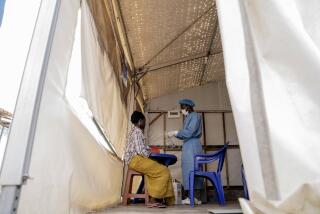Flu threat appears to be easing, government officials say
- Share via
LOS ANGELES AND MEXICO CITY — The number of swine flu cases continued its slow climb, reaching 263 in the United States and at least 937 in 19 countries worldwide, but both Mexican and U.S. authorities expressed cautious optimism Sunday that the outbreak may not be as severe as originally feared.
U.S. officials continued to express confidence that the H1N1 virus was not unusually virulent, but they cautioned that the number of cases and deaths would rise. In Mexico, however, officials said the disease was on the decline.
“What I can say is that we’re seeing encouraging signs,” Dr. Richard Besser, acting director of the Centers for Disease Control and Prevention, said on ABC News’ “This Week With George Stephanopoulos.” “That makes us all very happy.”
“When we get a virus we look to see: Does it relate to any other viruses?” Besser said. “And then we look for things that are called virulence factors, those things that in the past have been linked to more severe disease. And what we’ve found is that we’re not seeing the factors that were associated with the 1918 pandemic” that claimed millions of lives.
That 1918 virus, however, began mildly in the spring, but it returned in the fall in a more lethal form. Flu season is imminent in the Southern Hemisphere. Its severity and the way it spreads will help U.S. officials decide how to shape an H1N1 vaccine, and how much to produce.
Besser, who also appeared on CBS News’ “Face the Nation,” said on the show, “It’s a rapidly evolving situation, and it’s still one cloaked in uncertainty.”
But, he said, “we’re starting to see encouraging signs.”
Nevertheless, in a telephone news conference, the CDC’s Dr. Anne Schuchat cautioned against over-optimism. “We believe we are just in the upswing here,” she said. “I expect the numbers to jump quite a bit in the next few days” and for there to be more deaths.
“Virtually all of the United States probably has this virus circulating now,” she added. “That doesn’t mean that everybody’s infected, but within the communities, the virus has arrived.”
The strain has been found in at least 34 states. The only swine flu death in the United States has been a Mexican boy who was visiting Texas.
A few more schools across the nation were ordered closed Sunday, including 24 in a Detroit suburb after a high school student developed symptoms, and 14 in New Mexico after the state’s first swine flu case was confirmed.
In Mexico, where the strain first appeared, Health Secretary Jose Angel Cordova said the outbreak appeared to have peaked between April 23 and 28. “The evolution of the epidemic is now in its phase of descent,” he told a morning news conference, citing decreasing numbers of new cases and fewer hospital visits for influenza symptoms. “There is evidence that we are going downward.”
But Cordova said it was too soon to declare the crisis over or to relax restrictions aimed at preventing the spread of infection. He said officials needed more information before deciding, for example, whether to reopen Mexican schools, which have been ordered to remain closed until Wednesday.
“We shouldn’t let our guard down,” he said.
In the evening, Cordova said 590 cases of H1N1 have been confirmed in Mexico, as well as 22 deaths. The government will issue health guidelines for restaurants, cinemas and other businesses to help prevent the spread of disease, he said.
The guidelines will help the Mexican economy return to normal “little by little,” he said.
Mexico’s midterm congressional campaign officially opened Sunday, but the political parties have been ordered to refrain from rallies until the health crisis is over.
Elsewhere, the first confirmed cases of H1N1 were reported in Colombia and Ireland. New cases in Spain brought that country’s total to 40, but World Health Organization spokesman Gregory Hartl said virtually all of them were among travelers returning to Mexico and there was no evidence the virus was spreading widely through the population.
Officials were still puzzling over a report Saturday that about 200 pigs in Alberta, Canada, had contracted the virus after a Canadian swineherder brought it back from Mexico. Health authorities urged veterinarians and agricultural agents to increase their vigilance of swine but reiterated that there was absolutely no danger in consuming pork.
In Egypt, violence broke out among Christians whose herds of pigs were ordered slaughtered by the government -- despite the WHO’s assurance that the slaughter was unnecessary. In Cairo, more than 1,000 angry demonstrators pelted police with bottles and rocks. Twelve people were hospitalized and 14 arrested.
An estimated 300,000 pigs are raised and consumed by Egypt’s Christian minority. Farmers contend the government is using the swine flu outbreak as an excuse to crack down on those who raise pigs in their yards. The government said it would construct modern pigpens outside the city.
Egypt is primarily a Muslim nation, and Muslims do not eat pork.
--
ken.ellingwood@latimes.com
Mark Silva in the Washington bureau contributed to this report.
More to Read
Sign up for Essential California
The most important California stories and recommendations in your inbox every morning.
You may occasionally receive promotional content from the Los Angeles Times.






